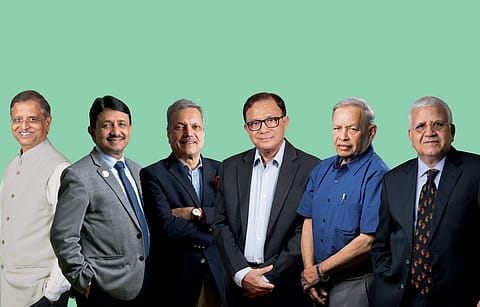How We Did It
The banks were scored on six broad parameters — business growth, asset quality, efficiency, profitability, capital adequacy, and investor perception.

This story belongs to the Fortune India Magazine May 2022 issue.
The Fortune India-Grant Thornton Bharat Best Banks ranking covers 57 scheduled commercial banks in India with a standalone balance sheet of over ₹10,000 crore as on March 31, 2021. This includes public sector banks, private banks, small finance banks and foreign banks.
The banks were divided into five categories:
Large domestic banks: Banks with standalone balance sheet size above ₹5,00,000 crore. This category had 10 banks comprising three private and seven PSBs.
Medium-sized domestic banks: Banks with standalone balance sheet size greater than ₹1,00,000 crore and less than or equal to ₹5,00,000 crore. This category had 14 banks with nine private and five public sector banks.
Small-sized domestic banks: Banks with standalone balance sheet size of over ₹10,000 crore and below or equal to ₹1,00,000 crore. This category had 8 private banks.
Small Finance Banks: This category consisted of 10 banks with small finance bank license.
Foreign banks: This category consisted of 15 foreign banks with standalone balance sheets of over ₹10,000 crore.
More Stories from this Issue
The banks were scored on six broad parameters — business growth, asset quality, efficiency, profitability, capital adequacy, and investor perception. In all, 27 sub-parameters were considered. The sub -parameters data was collected from annual reports, quarterly financial results and statistical tables from the Reserve Bank of India (RBI). For amalgamated banks, the base data for FY19 is taken as the consolidated number of merging banks.
In the first three categories, data for FY21 and 9M FY22 was considered. For small finance banks and foreign banks only FY21 data was considered, due to unavailability of published data for 9M FY22 for a few banks.
Business growth: This comprises seven sub-parameters including average growth in revenue for two years (FY19-21), average growth in deposit for two years, average growth in advances for two years, average growth in fee income for two years, absolute growth in operating profit for two years and absolute growth in net profit for two years. The same parameters excluding fee income growth were considered for 9M FY2022 for Dec’20-21. This was given a 20% weightage.
Asset quality: There are four sub-parameters under this including gross NPA percentage (FY21), movement in gross NPA for two years, net NPA percentage (FY21), movement of net NPA (FY19-21). The same parameters were considered for 9M FY22 for Dec’20-’21. This was given a 25% weightage.
(INR CR)
Efficiency: There are eight sub-parameters including cost to net income ratio (FY21), cost to average assets ratio (FY21), increase in RoA (FY19-21), increase in operating profit margin (FY19-21), revenue per branch and employee (FY21), profit per branch and employee (FY21). This was assigned a weightage of 15%.
Profitability: There are four sub-parameters under this — return on assets (FY21), fee income percentage (FY21), return on equity (FY21) and net interest margin percentage (FY21). The same parameters excluding fee income percentage were used for 9M FY22 analysis as well. This was assigned a weightage of 15%.
Capital adequacy: There are two sub-parameters under this — capital adequacy ratio and Tier 1 capital adequacy ratio. These parameters were considered for both FY21 and 9M FY22. This was assigned a 10% weightage.
Investor perception: There are three sub-parameters which included price to book value ratio (FY21), price to earnings ratio (FY21) and market cap growth (FY21). These parameters were considered for 9MFY22 as well. Weights were assigned as per the importance of parameters in deciding investor perception. This was assigned a weightage of 15%.
The scores in each parameter were standardised using a min-max scale. Banks were ranked within each parameter. The standardised scores under each parameter were multiplied with respective weights to arrive at area-wise scores. The area-wise scores (for eg. asset quality) were multiplied with respective area weights to arrive at scores for FY21. Similar exercise was done for 9M FY22 scores. Overall scores were arrived at by giving a weight of 70% for FY21 scores and 30% for 9M FY22 scores. The banks in each category were ranked based on the final scores. The scores obtained reflect a bank’s relative performance in specific parameters in its respective category and are not comparable across categories.
The findings were placed before an independent jury to identify the winners across the various categories. The jury members included Subhash Chandra Garg, former finance and economic affairs secretary, author of The $10 Trillion Dream, and chief policy advisor, SUBHANJALI; Satish Marathe, director on the board of RBI, and former chairman and CEO of The United Western Bank; HR Khan, former deputy governor, RBI, and currently independent director; Jitendra Gupta, former executive director, Sebi and founder, SES Governance, an independent proxy advisory firm; Pradip Shah, founder, IndAsia Fund Advisors and Debashis Mitra, president, Institute of Chartered Accountants of India.
Getting a consensus from the jury comprising current and former regulators (Satish Marathe, HR Khan and JN Gupta), bureaucrat (Satish Garg), chartered accountant (Debashis Mitra) and an investment professional (Pradip Shah) took more than one meeting to arrive at the winners as the jury debated at length on the five categories. Please flip over to look at how India’s Best Banks stack up in the Fortune India-Grant Thornton Bharat study.